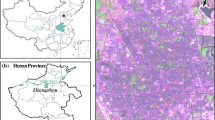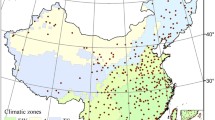Abstract
This paper intended to examine the seasonal variations in the relationship between landscape pattern and land surface temperature based on a case study of Indianapolis, United States. The integration of remote sensing, GIS, and landscape ecology methods was used in this study. Four Terra’s ASTER images were used to derive the landscape patterns and land surface temperatures (LST) in four seasons in the study area. The spatial and ecological characteristics of landscape patterns and LSTs were examined by the use of landscape metrics. The impact of each land use and land cover type on LST was analyzed based on the measurements of landscape metrics. The results show that the landscape and LST patterns in the winter were unique. The rest of three seasons apparently had more agreeable landscape and LST patterns. The spatial configuration of each LST zone conformed to that of each land use and land cover type with more than 50% of overlap in area for all seasons. This paper may provide useful information for urban planers and environmental managers for assessing and monitoring urban thermal environments as result of urbanization.
Similar content being viewed by others
References
Aguiar, R., Oliveira, M., & Goncalves, H. (2002). Climate change impacts on the thermal performance of Portuguese buildings. Results of the SIAM study. Building Service Engineers Research and Technology, 23(4), 223–231.
Alberti, M. (2005). The effects of urban patterns on ecosystem function. International Regional Science Review, 28(2), 168–192.
ASTER online products description. (2005). Retrieved from http://asterweb.jpl.nasa.gov/content/03_data/01_Data_Products/SurfaceTemperature.pdf.
Bain, D. J., & Brush, G. S. (2004). Placing the pieces: Reconstructing the original property mosaic in a warrant and patent watershed. Landscape Ecology, 19(8), 843–856.
Bender, O., Boehmer, H. H., Jens, D., & Schumacher, K. P. (2005). Analysis of land-use change in a sector of Upper Franconia (Bavaria, Germany) since 1850 using land register records. Landscape Ecology, 20(2), 149–163.
Boyd, D. S., Foody, G. M., Curran, P. J., Lucas, R. M., & Honzak, M. (1996). An assessment of radiance in Landsat TM middle and thermal infrared wavebands for the detection of tropical forest regeneration. International Journal of Remote Sensing, 17(2), 249–261.
Conway, T. G. (1997). Improved remote heat sensing. Mechanical Engineering, 119, 88–89.
Forman, R. T. T., & Godron, M. (1986). Landscape ecology. New York: Wiley.
Franklin, J. F., & Forman, R. T. T. (1987). Creating landscape patterns by forest cutting: ecological consequences and principles. Landscape Ecology, 1, 5–18.
Frohn, R. C. (1998). Remote sensing for landscape ecology. Boca Raton, FL: Lewis.
Goetz, S. Z. (1997). Multisensor analysis of NDVI, surface temperature and biophysicalvariables at a mixed grassland site. International Journal of Remote Sensing, 18, 71–94.
Gustafson, E. J. (1998). Quantifying landscape spatial pattern: What is the state of the art? Ecosystems, 1, 143–156.
Jacob, F., Olioso, A., Gu, X., Su, Z., & Seguin, B. (2002). Mapping surface fluxes using visible, near infrared, thermal infrared remote sensing data with a spatialized surface energy balance model. Agronomie: Agriculture and Environment, 22, 669–680.
Kasischke, E. S., Smith, K. B., Bourgeau-Chavez, L. L., Romanowicz, E. A., Brunzell, S., & Richardson, C. J. (2003). Effects of seasonal hydrologic patterns in south Florida wetlands on radar backscatter measured from ERS-2 SAR imagery. Remote Sensing of Environment, 88, 423–441.
Kato, S., & Yamaguchi, Y. (2006). Analysis of urban heat-island effect using ASTER and ETM+data: separation of anthropogenic heat discharge and natural heat radiation from sensible heat flux. Remote Sensing of Environment, 99, 44–54.
Krummel, J. R., Gardner, R. H., Sugihara, G., O’Neill, R. V., & Coleman, P. R. (1987). Landscape patterns in a distrurbed environment. Oikos, 48, 321–324.
Li, H., & Wu, J. (2004). Use and misuse of landscape indices. Landscape Ecology, 19(4), 389–399.
Lu, D., & Weng, Q. (2004). Spectral mixture analysis of the urban landscape in indianapolis with landsat ETM+imagery. Photogrammetric Engineering & Remote Sensing, 70(9), 1053–1062.
Luvall, J. C., & Holbo, H. R. (1991). Thermal remote sensing methods in landscape ecology. In quantitative methods in landscape ecology. New York: Springer.
Magee, N., Curtis, J., & Wendler, G. (1999). The urban heat island effect at Fairbanks, Alaska. Theoretical and Applied Climatology, 64, 39–47.
Mandelbrot, B. B. (1983). The fractal geometry of nature. San Francisco, CA: Freeman.
McGarigal, K., Marks, B. J. (1995). FRAGSTATS: Spatial pattern analysis program for quantifying landscape structure. General Technical Report PNW-GTR-351. Portland, OR: USDA Forest Service. Pacific Northwest Research Station.
McGarigal, K., Cushman, S. A., Neel, M. C., Ene, E. (2002). FRAGSTATS: Spatial pattern analysis program for categorical maps. Computer software program produced by the authors at the University of Massachusetts, Amherst. Retrieved from www.umass.Edu/landeco/research/fragstats/fragstats.
McVicar, T. R., & Jupp, D. L. B. (1998). The current and potential operational uses of remote sensing to aid decisions on drought exceptional circumstances in Australia: a review. Agriculture Systems, 57, 399–468.
Myeong, S., Nowak, D. J., & Duggin, M. J. (2006). A temporal analysis of urban forest carbon storage using remote sensing. Remote Sensing of Environment, 101, 277–282.
O’Neill, R. V., Krummel, J. R., Gardner, R. H., Sugihara, G., Jackson, B., DeAngelis, D. L., Milne, B. T., Turner, M. G., Zygmunt, B., Christensen, S., Dale, V. H., & Graham, R. L. (1988). Indices of landscape pattern. Landscape Ecology, 1, 153–162.
Pan, D., Domon, G., Marceau, D., & Bouchard, A. (2001). Spatial pattern of coniferous and deciduous forest patches in an Eastern North America agricultural landscape: the influence of land use and physical attributes. Landscape Ecology, 16(2), 99–110.
Peterjohn, W. T., & Correll, D. L. (1984). Nutrient dynamics in an agricultural watershed: observations on the role of a riparian forest. Ecology, 65, 1466–1475.
Pickett, S. T. A., Kolasa, J., & Jones, C. G. (1994). Ecological understanding. San Diego, Carlifornia, USA: Academic.
Quattrochi, D. A., & Luvall, J. C. (1999). Thermal infrared remote sensing for analysis of landscape ecological process: methods and applications: methods and applications. Landscape Ecology, 14, 577–598.
Quattrochi, D. A., & Ridd, M. K. (1998). Analysis of vegetation within a semi-arid urban environment using high spatial resolution airborne thermal infrared remote sensing data. Atmosphere Environment, 32(1), 19–33.
Riitters, K. H., O’Neill, R. V., Hunsaker, C. T., Wickham, J. D., Yankee, D. H., & Timmins, S. P. (1995). A factor analysis of landscape pattern and structure metrics. Landscape Ecology, 10(1), 23–39.
Smith, R. M. (1986). Comparing traditional methods for selecting class intervals on choropleth maps. Professional Geographer, 38(1), 62–67.
Streutker, D. (2002). A remote-sensing study of the urban heat island of Houston, Texas. International Journal of Remote Sensing, 23, 2595–2608.
Streutker, D. (2003). Satellite-measured growth of the urban heat island of Houston, Texas. Remote Sensing of Environment, 85, 282–289.
Turner, M. G. (1990). Spatial and temporal analysis of landscape patterns. Landscape Ecology, 4(1), 21–30.
Voogt, J. A., & Oke, T. R. (1997). Complete urban surface temperatures. Journal of Applied Meteorology, 36, 1117–1132.
Voogt, J. A., & Oke, T. R. (1998). Effects of urban surface geometry on remotely-sensed surface temperature. International Journal of Remote Sensing, 19(5), 895–920.
Voogt, J. A., & Oke, T. R. (2003). Thermal remote sensing of urban climates. Remote Sensing of Environment, 86, 370–384.
Wan, Z., & Dozier, J. (1996). A generalized split-window algorithm for retrieving land-surface temperature from space. IEEE Transactions on Geoscience and Remote Sensing, 34(2), 892–905.
Wan, Z., Wang, P., & Li, X. (2004a). Using MODIS land surface temperature and normalized difference vegetation index products for monitoring drought in the southern Great Plains, USA. International Journal of Remote Sensing, 25(1), 61–72.
Wan, Z., Zhang, Y., Zhang, Q., & Li, Z.-L. (2004b). Quality assessment and validation of the MODIS global land surface temperature. International Journal of Remote Sensing, 25(1), 261–274.
Wang, Y., Zhang, X., Liu, H., Ruthie, H. K. (1999). Landscape characterization of metropolitan Chicago region by Landsat TM. The Proceeding of ASPRS annual conference, 238–247.
Weng, Q., Lu, D., & Schubring, J. (2004). Estimation of land surface temperature-vegetation abundance relationship for urban heat island studies. Remote Sensing of Environment, 89, 467–483.
Wu, J., Dennis, E. J., Matt, L., & Paul, T. T. (2000). Multiscale analysis of landscape heterogeneity: scale variance and pattern metrics. Geographic Information Sciences, 6(1), 6–19.
Author information
Authors and Affiliations
Corresponding author
Rights and permissions
About this article
Cite this article
Liu, H., Weng, Q. Seasonal variations in the relationship between landscape pattern and land surface temperature in Indianapolis, USA. Environ Monit Assess 144, 199–219 (2008). https://doi.org/10.1007/s10661-007-9979-5
Received:
Accepted:
Published:
Issue Date:
DOI: https://doi.org/10.1007/s10661-007-9979-5




